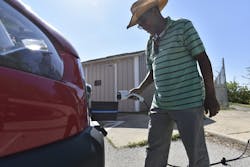Missouri Army base embracing EVs, Charging Infrastructure, Cogeneration power
Fort Leonard Wood, a U.S. Army training installation located in the Missouri Ozarks, is installing EV charging stations, replacing non-tactical government-owned vehicles with EVs and installing two combined heat-and-power (CHP) plants as it focuses on resiliency and sustainability.
Fort Leonard Wood received two EVs last month and will continue to receive more EVs in the future. The electric vans it received at the Logistic Readiness Center are part of the U.S. Army’s directive to electrify its non-tactical vehicles.
The directive requires the Department of Defense to transition to 100% zero-emissions non-tactical vehicle fleet by 2027. This includes light-duty acquisitions. All its medium- and heavy-duty acquisitions will be transitioned to zero-emissions vehicles by 2035.
Fort Leonard Wood has some 540 non-tactical vehicles.
The Directorate of Public Works intends to have charging stations installed ahead of the arrival of the rest of the EVs. It will have one EV charging station for every four to six EVs. The first seven charging stations are expected to be operational in a month or two. For the charging stations, the DPW intends to privatize the ownership under an existing electrical distribution contract.
Installation Energy Manager Allen Simpson with the Directorate of Public Works explained, “First of all, we save on manpower of managing the purchases, operation and maintenance, and we don’t have to worry about life-cycle replacement. We will simply pay a monthly fee, just as we do for maintaining our other utility distribution systems.”
Meanwhile, DPW is also working with the U.S. Army Corps of Engineers to install two CHP plants at Fort Leonard Wood. These cogeneration plants will capture heat lost during power generation and utilise it for heating and cooling, reducing costs.
“The efficiency comes because we are capturing the heat that’s produced in that process and putting that heat into a boiler plant,” Simpson said. “So, we’re not having to buy that natural gas to heat the boilers. The natural gas offsets itself while we are able to produce our own electricity.”
Once complete, the cogeneration plants will enable the Fort Leonard Wood facility to produce about 7% of its peak-power demand.
Additionally, DPW and the USACE Prime Power School have collaborated to train service members to install, operate and maintain certain types of electrical power plants.
Fort Hood successfully islands from main Texas grid
U.S. Army details Climate Strategy
Earlier this year, the U.S. Army released a long-term climate strategy that intends to install a microgrid at every installation by 2035. The force also will field an all-electric light-duty non-tactical vehicle fleet by 2027 and take all of the non-tactical fleet electric by 2035.
About the Author
EnergyTech Staff
Rod Walton is senior editor for EnergyTech.com. He has spent 17 years covering the energy industry as a newspaper and trade journalist.
Walton formerly was energy writer and business editor at the Tulsa World. Later, he spent six years covering the electricity power sector for Pennwell and Clarion Events. He joined Endeavor and EnergyTech in November 2021.
He can be reached at [email protected].
EnergyTech is focused on the mission critical and large-scale energy users and their sustainability and resiliency goals. These include the commercial and industrial sectors, as well as the military, universities, data centers and microgrids.
Many large-scale energy users such as Fortune 500 companies, and mission-critical users such as military bases, universities, healthcare facilities, public safety and data centers, shifting their energy priorities to reach net-zero carbon goals within the coming decades. These include plans for renewable energy power purchase agreements, but also on-site resiliency projects such as microgrids, combined heat and power, rooftop solar, energy storage, digitalization and building efficiency upgrades.
